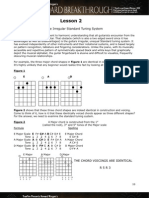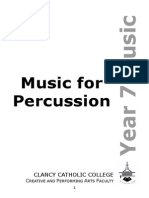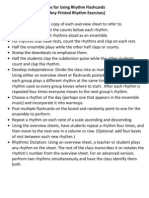African Composing
African Composing
Uploaded by
andy_bowden_7Copyright:
Available Formats
African Composing
African Composing
Uploaded by
andy_bowden_7Original Description:
Copyright
Available Formats
Share this document
Did you find this document useful?
Is this content inappropriate?
Copyright:
Available Formats
African Composing
African Composing
Uploaded by
andy_bowden_7Copyright:
Available Formats
Y E A R
U N I T
A F R I C A N
Name
M U S I C
W 5
Form
Now that you have learned about RHYTHMS, CYCLIC RHYTHMS, POLYRHYTHMS,
SYNCOPATION and CALL AND RESPONSE as features used in African music, its time
to compose your own African-inspired piece of music using these features.
1. Begin by composing your own RHYTHM. You can use some of the names of African
countries, from the map below, to help you. Try to include some SYNCOPATION and
write your rhythm in the rhythm grid below.
W W W . M U S I C A L C O N T E X T S . C O . U K
Y E A R
U N I T
A F R I C A N
M U S I C
W 5
2. Next, think about which INSTRUMENT you are going to perform your African rhythm on.
If youre performing it on an African drum, such as a DJEMBE, try to use BASS (B), TONE
(T) and SLAP (S) strokes to vary the sound adding the letters, B, T and S to your rhythm
grid below. If youre using a PITCHED instrument such as a xylophone to imitate the
African BALAFON, work out which note names or PITCHES youll use and write these on
the rhythm grid below.
My rhythm is being performed on
3. Practice repeating this rhythm over and over turning it into a CYCLIC
RHYTHM. Tick the box when you have completed this.
I have created my own rhythm, decided on which instrument
to perform this and can repeat it as a CYCLIC RHYTHM.
4. Now, form a group of between 5 and 6 people. Share each others rhythms by writing
them on the rhythm grid below, together with the instrument they are using.
5. Create a POLYRHYTHMIC texture by deciding who will start performing their CYCLIC
rhythm first and who will come in next and in what order. Also think about HOW MANY
TIMES each person is going to perform their rhythms. Add the numbers 1-6 against each
row in the table above to help remind you on the order of the rhythms. Now, practice with
each group member performing their rhythm at the correct time. Tick the box when your
group have completed this.
We have decided upon an order in which to perform each members CYCLIC
RHYTHMS and have rehearsed this creating a POLYRHYTHMIC texture.
W W W . M U S I C A L C O N T E X T S . C O . U K
Y E A R
U N I T
A F R I C A N
M U S I C
W 5
6. Now its time to add some CALL AND RESPONSE to your African-inspired piece.
Decide on who will be the MASTER DRUMMER and create a CALL writing your rhythm in
the box below, using words if this helps you remember it.
Next, create a RESPONSE which is performed by all the other members of the group and
write this in the rhythm box below.
You could also take it in turns being the MASTER DRUMMER performing the CALL and
allowing each group member to IMPROVISE a response which will be different each time.
Tick the box when you have completed your call and response section.
We have created a CALL AND RESPONSE pattern and can perform this
together as a group.
7. Putting your African piece together
Now that you each have a RHYTHM, can perform these as a POLYRHYTHM and have a
CALL AND RESPONSE section. You need to put your piece together. Use the box
below to work out a STRUCTURE to your piece. Work out an INTRODUCTION and
ENDING and decide when and how many times you will use your POLYRHYTHM and
CALL AND RESPONSE sections. Also think about how you will move or change from
section to section? Will you have a cue or signal? Use a different sound from an
instrument or use vocal signals and shouts?
Finally, think about a name or title for your piece
W W W . M U S I C A L C O N T E X T S . C O . U K
You might also like
- Beginning Baglama SazDocument20 pagesBeginning Baglama Sazjaym43100% (3)
- Golden Ears Audio Eartraining (Manual)Document100 pagesGolden Ears Audio Eartraining (Manual)ikolev57No ratings yet
- Mt21c Practice ExercisesDocument80 pagesMt21c Practice ExercisesJake ArthurNo ratings yet
- Notion 4 ShortcutsDocument3 pagesNotion 4 ShortcutsQuinn MasonNo ratings yet
- Rite of Spring WorksheetDocument4 pagesRite of Spring WorksheetBenjamin BuchananNo ratings yet
- Cubase 5 Español Como EmpezarDocument192 pagesCubase 5 Español Como EmpezarMoises Reznik100% (1)
- Scott Smalley Orchestration (Notes in Norwegian)Document1 pageScott Smalley Orchestration (Notes in Norwegian)Øyvind MathisenNo ratings yet
- Anthology of Harmonica TuningsDocument69 pagesAnthology of Harmonica TuningsMox Gowland100% (2)
- Manuel Philippine Musical InstrumentsDocument79 pagesManuel Philippine Musical InstrumentsJessicaNo ratings yet
- Classics Groove 1Document1 pageClassics Groove 1maria ballesterosNo ratings yet
- Epic MusicDocument7 pagesEpic MusicPaulo LeónNo ratings yet
- Form and Structure 1Document6 pagesForm and Structure 1ticklyears100% (1)
- Music Composition 3di3 - GardnerDocument61 pagesMusic Composition 3di3 - GardnerlancillottoNo ratings yet
- Graphic OrganizerDocument10 pagesGraphic OrganizerCristine AbadierNo ratings yet
- Rhythm and MeterDocument2 pagesRhythm and MeterAlejandroPerdomoNo ratings yet
- Classical Guitarist ComposersDocument2 pagesClassical Guitarist ComposersQuinn ParsleyNo ratings yet
- Texture in MusicDocument5 pagesTexture in MusicRaychow Goninan100% (1)
- Lilypond Notation SamplerDocument1 pageLilypond Notation SamplerJames100% (1)
- The Workout Part 2: Eric VandenbergDocument5 pagesThe Workout Part 2: Eric Vandenberghsl2013No ratings yet
- ConceptsDocument2 pagesConceptschenNo ratings yet
- Def S Sonata and Fugue FormsDocument2 pagesDef S Sonata and Fugue FormsAliz328No ratings yet
- Slicing The Beat - Jazz Eighth-Notes As Expressive MicrorhythmDocument27 pagesSlicing The Beat - Jazz Eighth-Notes As Expressive Microrhythmmarcus motaNo ratings yet
- Theory An Dear Training Student HandbookDocument16 pagesTheory An Dear Training Student HandbookguitarmrNo ratings yet
- 1 Sinfonia EroicaDocument27 pages1 Sinfonia Eroicajorge santoroNo ratings yet
- Sibelius Film ScoringDocument11 pagesSibelius Film ScoringPety MontielNo ratings yet
- Creating An Effective Audience Development Plan - The Audience AgencyDocument25 pagesCreating An Effective Audience Development Plan - The Audience AgencyIago HermoNo ratings yet
- MauroGiuliani - 120 - RH - Studies PDFDocument15 pagesMauroGiuliani - 120 - RH - Studies PDFJeffersonFinhoNo ratings yet
- Hans Zimmer Operation GuideDocument33 pagesHans Zimmer Operation GuideEric AdjeiNo ratings yet
- Rick Graham-I Can Feel U Breathe PDFDocument7 pagesRick Graham-I Can Feel U Breathe PDFbufalmacoNo ratings yet
- Six Stages in Composing MusicDocument3 pagesSix Stages in Composing MusicAlexander DeVaronNo ratings yet
- Bartok Duo 44 ViolinDocument1 pageBartok Duo 44 ViolinDaniel PrietoNo ratings yet
- 11 Emotional and Sad Chord Progressions You Should Know - LANDRDocument18 pages11 Emotional and Sad Chord Progressions You Should Know - LANDRTony de SouzaNo ratings yet
- Symphony Orchestra Management PlanDocument4 pagesSymphony Orchestra Management Planapi-273161489No ratings yet
- An Experimental Music TheoryDocument10 pagesAn Experimental Music Theoryjuan marti100% (1)
- 12-Graphic Notation and PerformanceDocument6 pages12-Graphic Notation and PerformanceZoila Elgarte100% (1)
- Vencendo Vem Jesus - GradeDocument13 pagesVencendo Vem Jesus - Gradelarissamanujuju100% (1)
- Lesson 2: $CC55/C A A ADocument6 pagesLesson 2: $CC55/C A A Amomacki100% (2)
- Musical Temporality. Perspectives From Adorno and de Man: Robert AdlingtonDocument56 pagesMusical Temporality. Perspectives From Adorno and de Man: Robert AdlingtoneugenioamorimNo ratings yet
- Adams - Melodic Contour TypologyDocument38 pagesAdams - Melodic Contour TypologyHugo Leonardo Ribeiro100% (1)
- How To Add SparkleDocument6 pagesHow To Add Sparklemadhuraju778797No ratings yet
- The Alchemist (Musician)Document9 pagesThe Alchemist (Musician)miltodiavoloNo ratings yet
- Beringer Daily Technical StudiesDocument91 pagesBeringer Daily Technical StudiesRGB100% (1)
- 2019 Nafme All-Northwest Jazz Audition Materials Saxophones and BrassDocument14 pages2019 Nafme All-Northwest Jazz Audition Materials Saxophones and BrassBugMeNotNo ratings yet
- 5 Fundamentals Ear Training Exam PDFDocument3 pages5 Fundamentals Ear Training Exam PDFJim KirbyNo ratings yet
- Assessment Ideas For Beginning Level Guitar Class - Teaching Guitar Workshops - The Guitar EducationDocument4 pagesAssessment Ideas For Beginning Level Guitar Class - Teaching Guitar Workshops - The Guitar EducationTracy WayneNo ratings yet
- The Ladder Exercises - GuitarDocument10 pagesThe Ladder Exercises - Guitarseila09No ratings yet
- Daily Pract RoutDocument1 pageDaily Pract RoutCol BoyceNo ratings yet
- 099fast FingersDocument2 pages099fast FingersMarie MayNo ratings yet
- Using Gamaka To Add Indian Flavor To Your Guitar Playing PDFDocument8 pagesUsing Gamaka To Add Indian Flavor To Your Guitar Playing PDFtrancegodzNo ratings yet
- John Hollenbeck CV 12-29-2014Document5 pagesJohn Hollenbeck CV 12-29-2014MioMaulenovoNo ratings yet
- Super Mario Bros: The Role of Music in Platform GamingDocument20 pagesSuper Mario Bros: The Role of Music in Platform GamingNathan PoetschkaNo ratings yet
- 087 Marty Friedman - Exotic Metal Booklet PDFDocument5 pages087 Marty Friedman - Exotic Metal Booklet PDFRicardo AndréNo ratings yet
- Cipher FormulaDocument18 pagesCipher FormulaFrank BozNo ratings yet
- Fugue, Part 1Document8 pagesFugue, Part 1Matt RosenthalNo ratings yet
- The Basic Elements of Music 8.8Document111 pagesThe Basic Elements of Music 8.8Sacred Heart Academy of La Loma100% (1)
- African Drumming Booklet - DIGITALDocument8 pagesAfrican Drumming Booklet - DIGITALfathimalamiahmnNo ratings yet
- Introduction To The Scale Syllabus For Jazz - Jamey AebersoldDocument1 pageIntroduction To The Scale Syllabus For Jazz - Jamey AebersoldCwasi Musicman0% (1)
- Learn Rap From Raftaar AssignmentsDocument2 pagesLearn Rap From Raftaar AssignmentsDhairya kapoorNo ratings yet
- 2012 7 2 Music For Percussion Booklet PDFDocument20 pages2012 7 2 Music For Percussion Booklet PDFapi-247725573100% (1)
- Rhythm Class Stéphane Galland 2021Document2 pagesRhythm Class Stéphane Galland 2021hoplalaNo ratings yet
- Scale SyllabusDocument2 pagesScale SyllabusLillo GallettaNo ratings yet
- Ideas For Using Rhythm Flashcards (Or Any Printed Rhythm Exercises)Document1 pageIdeas For Using Rhythm Flashcards (Or Any Printed Rhythm Exercises)n1ranNo ratings yet
- Ukulele Coldplay - Viva La VidaDocument3 pagesUkulele Coldplay - Viva La VidaJohnnyNo ratings yet
- Scotland: Scotland Is A Country That Is Part of The United Kingdom and Covers TheDocument11 pagesScotland: Scotland Is A Country That Is Part of The United Kingdom and Covers TheTOMITA DANIELANo ratings yet
- History of The Philippine Folk Dance PDFDocument2 pagesHistory of The Philippine Folk Dance PDFSamanthaNo ratings yet
- Espana Cani For 3 TrumpetsDocument22 pagesEspana Cani For 3 TrumpetsKevin Rúa LagosNo ratings yet
- Folk Dance Part - 1Document67 pagesFolk Dance Part - 1ankitgandu555No ratings yet
- Moonspell - Vampiria InicioDocument6 pagesMoonspell - Vampiria InicioDannyela Peña SanchezNo ratings yet
- Tracey Flyer A4 2Document1 pageTracey Flyer A4 2CareNo ratings yet
- University of The Philippines Madrigal SingersDocument1 pageUniversity of The Philippines Madrigal SingersEmman AguilarNo ratings yet
- Silent Night Άγια Νύχτα: F.GruberDocument2 pagesSilent Night Άγια Νύχτα: F.GruberΝεκταρίαΛαουμτζήNo ratings yet
- Flamenco RythmsDocument12 pagesFlamenco RythmsHaris ANo ratings yet
- Orange Blossom Special TrioDocument2 pagesOrange Blossom Special TrioRodrigo ReisNo ratings yet
- PDF Babe Im Gonna Leave YouDocument32 pagesPDF Babe Im Gonna Leave Youhenry rossNo ratings yet
- Concerto For Crash CymbalsDocument2 pagesConcerto For Crash CymbalsKrista ReederNo ratings yet
- Sutalo BabaDocument3 pagesSutalo BabaPramod DevalNo ratings yet
- Song DownloadDocument4 pagesSong DownloadmsriramcaNo ratings yet
- 24 Newsletter12 20 11Document16 pages24 Newsletter12 20 11Rick MillmanNo ratings yet
- Chelsea MorningDocument2 pagesChelsea MorningPiero OrtolaniNo ratings yet
- December The Thrill Is GoneDocument5 pagesDecember The Thrill Is GoneYorik TenesNo ratings yet
- Alison Balsom Scottish Ensemble: and TheDocument11 pagesAlison Balsom Scottish Ensemble: and TheFabian CorralesNo ratings yet
- Ian Shanahan - Authenticity - PointsDocument3 pagesIan Shanahan - Authenticity - PointsIan ShanahanNo ratings yet
- MSC110 - Fall2022 - Final Project - Dağlı - SerhanDocument3 pagesMSC110 - Fall2022 - Final Project - Dağlı - SerhanSerhan DağlıNo ratings yet
- Developing IntonationDocument2 pagesDeveloping IntonationsgerasimosNo ratings yet
- Moten Swing-Arr. Ernie Wilkins - BassDocument4 pagesMoten Swing-Arr. Ernie Wilkins - BassBrody GreeneNo ratings yet
- Prayer in C TabDocument2 pagesPrayer in C TabRoberto Jales TorresNo ratings yet
- Festivals Trinidad & TobagoDocument37 pagesFestivals Trinidad & TobagoPress Tours100% (1)
- CLXX PDFDocument10 pagesCLXX PDFDamion HaleNo ratings yet
- Cello ReportDocument15 pagesCello ReportCharles Ventura Ramos II75% (4)
- 2014.12.16 Listado MercuzioDocument48 pages2014.12.16 Listado Mercuziopepe_carambola0% (1)

























































































